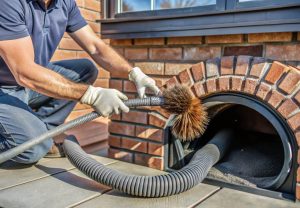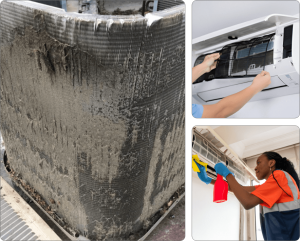You’ve just finished that kitchen renovation you’ve been planning for years. The new cabinets look amazing, the countertops are exactly what you wanted, and everything is finally installed and perfect. You’re ready to enjoy your beautiful new space. But, not quite just yet. There’s dust everywhere, even though you just cleaned. Your allergies are acting up. And no matter how much you vacuum, that fine layer of dust keeps reappearing on every surface.
Renovation creates dust and debris that infiltrates your ductwork. And once it’s in there, it’s hard to get rid of without air duct cleaning in NJ.
What is Construction Dust?
Construction and renovation activities generate massive amounts of particulate matter that’s finer and more pervasive than normal dust. We’re talking about drywall dust, sawdust from cutting lumber or other materials, concrete and masonry dust containing silica and other minerals, paint particles and chemical residues, insulation fibers that can be irritating to lungs, adhesive and caulk vapors that leave residues.
The challenge with construction dust is how fine these particles are. Drywall dust, in particular, is so fine that it becomes airborne extremely easily and can stay suspended in the air for extended periods. This means it circulates through your home’s air and finds its way into every crack, crevice, and opening.
Also Read: Will Air Duct Cleaning Reduce Dust?
How Does Construction Debris Infiltrate Your Ductwork?
While dust barriers and plastic sheeting help, they’re rarely helpful.
Here’s how construction debris gets into your ducts even when you’re trying to prevent it:
1. Air Pressure Dynamics
When your HVAC system runs during renovation, it creates negative and positive pressure zones throughout your home. Dusty air gets pulled toward return vents even through plastic barriers and sealed doorways.
2. Return Vents are Vacuum Cleaners
If your HVAC system runs at all during renovation, and most homeowners can’t go weeks without heat or AC, those return vents are actively pulling dusty air into the ductwork.
3. Vibrations Dislodge Existing Dust
Heavy construction work creates vibrations that shake loose accumulated dust and debris that’s been sitting in your ducts for years. This old contamination combines with new construction dust to create even worse indoor air quality.
4. Uncovered Vents During Work
When contractors remove vent covers for painting or drywall work, even if it’s just for a little while, massive amounts of dust can enter the duct system.
5. Pressure Changes from Opened Windows and Doors
Construction creates additional air movement patterns that help spread dust throughout the home and into ductwork openings.
The unfortunate reality is that unless you completely shut down and seal your HVAC system during renovation, which most people don’t do, construction dust will infiltrate your ductwork to some degree.
Types of Renovations That Create the Most Duct Contamination
1. Kitchen Renovations
These get particularly dusty because they often involve multiple trades working in a confined space. Demolition of old cabinets and countertops, drywall work for new layouts, tile cutting and installation, and extensive painting all generate dust that easily spreads through the home.
2. Bathroom Remodels
Bathroom remodels create similar issues with tile work, which is especially problematic. Cutting ceramic or porcelain tiles generates extremely fine dust that becomes airborne easily. Demo work in bathrooms often involves breaking up tile, which creates even more particulate matter.
3. Basement Finishing
Such projects are notorious for duct contamination because they often involve extensive framing, drywall installation, and concrete work, all happening directly adjacent to ductwork and HVAC equipment that’s typically located in basements.
4. Whole-House Renovations
These create the most contamination simply because of the scale of work involved. When multiple rooms are under construction simultaneously, dust control becomes nearly impossible.
5. Hardwood Floor Refinishing
Floor sanding generates enormous amounts of fine sawdust that easily becomes airborne. Even when professionals use dust containment systems, some dust escapes and infiltrates ductwork.
6. Attic Conversions
Attic conversions are problematic because work is happening directly above ductwork and often involves cutting into the roof or exterior walls, creating pathways for insulation fibers and other debris to enter the HVAC system.
Health Impacts of Contaminated Ductwork
Contaminated ductwork after renovation creates real health concerns. Post-renovation, you might notice residents experiencing heightened allergy symptoms, including sneezing, coughing, and itchy eyes.
This happens because construction dust contains allergens and irritants that are now being continuously circulated through your home.
1. Respiratory Issues
Fine particulate matter from drywall, wood, and other materials can irritate airways, trigger asthma attacks, and cause breathing difficulties, particularly in children, elderly residents, and people with existing respiratory conditions.
2. Chemical Exposure
Many construction materials, off-gassing chemicals, paint, adhesives, caulks, and treated wood all release volatile organic compounds that can be absorbed by dust particles in your ductwork and then redistributed throughout your home for months after renovation is complete.
3. Mold Risk Increases
When construction dust combines with any moisture in the ductwork, it’s particularly difficult to remediate.
4. Long-Term Exposure Concerns
Contaminated ductwork means ongoing exposure every time your heating or cooling system runs. This continuous low-level exposure can have cumulative health effects.
When Should You Schedule Post-Renovation Duct Cleaning?
Timing matters when it comes to post-renovation air duct cleaning in NJ. Clean too early, and ongoing work might recontaminate your system.
Wait too long, and you’re breathing compromised air and potentially damaging your HVAC equipment.
Immediately After Construction Completion
Duct cleaning should be performed as soon as possible after construction is complete so that any dust or debris created during the building process is thoroughly removed before the HVAC system is fully operational.
The timing works best when all renovation work is finished, all final cleanup has been completed, new HVAC filters have been installed, and before you fully occupy the renovated space.
Before Moving Furniture Back
This just makes access easier and more thorough. If you’re renovating a room, schedule duct cleaning before bringing furniture and belongings back into the space.
After Final Walkthrough
Before signing off on contractor work, make sure that any dust generated during final touches is included in the cleaning.
Some homeowners make the mistake of cleaning ducts mid-renovation when work pauses. This is wasteful; ongoing construction will simply recontaminate the system, requiring you to clean again after work is completed.
What Does Professional Post-Renovation Duct Cleaning Involve?
After construction is complete and before operating the HVAC, ducts should be cleaned using a vacuum and pneumatic brushing system made for duct cleaning. It’s important that you never use wet solutions or ultraviolet light systems, as these aren’t appropriate for construction debris removal.
Step 1: System Inspection
This step identifies the extent of contamination and any damage that might have occurred during construction. It involves inspecting visible ductwork, checking all registers and returns, evaluating HVAC equipment condition, and documenting the starting condition.
Step 2: Source Removal Cleaning
This involves physically removing debris using powerful vacuum systems, rotary brushes, and pneumatic tools to dislodge adhered particles, and agitation devices that reach deep into ductwork.
Step 3: Register and Grill Cleaning
Register and grille cleaning helps address where dust accumulation is most noticeable. All vent covers should be removed, cleaned thoroughly, and reinstalled.
Step 4: HVAC Component Cleaning
This should include the blower assembly, evaporator coil, heat exchanger surfaces, and any other components that accumulated construction dust.
Step 5: Air Handler Protection
This process includes powerful vacuuming, brushing, and sanitizing air conditioning ducts to remove and neutralize harmful particles, with specialized equipment making sure no contamination is left behind.
What’s The Difference Between Regular and Post-Renovation Cleaning?
You’re probably wondering whether regular and post-renovation cleaning is any different. The truth is, they couldn’t be more poles apart. Here are the main differences:
1. Debris Volume
With post-renovation cleaning, you’re looking at significantly higher debris. Standard residential duct cleaning might extract a few pounds of dust and debris. Post-renovation cleaning can pull out tens of pounds of construction materials, including chunks of drywall, insulation pieces, sawdust clumps, and even fasteners or small tools accidentally dropped into ducts.
2. Cleaning Methods
Routine cleaning uses light agitation and vacuuming; post-renovation work requires more aggressive brushing, multiple passes through each duct section, and potentially specialized tools for dislodging adhered construction dust.
3. Filters
After routine cleaning, your regular filter schedule continues normally. After post-renovation cleaning, you should use high-quality filters and change them more frequently for the first few months, as any remaining fine particles are captured.
Signs You Need Post-Renovation Cleaning
Sometimes homeowners aren’t sure whether duct cleaning is really necessary after their renovation. Here are clear indicators that it is:
1. Visible Dust
Any dust accumulation around vents and registers indicates dust being expelled from your ductwork. If you’re seeing dust buildup shortly after cleaning, it’s coming from inside your ducts.
2. Persistent Dustiness Throughout Your Home
You’re at your wits’ end cleaning every nook and cranny of your home, but if you keep getting dust back, it’s high time you need your ductwork cleaned.
3. Increased Allergy Symptoms
If you’ve noticed getting sick more frequently or experiencing allergy symptoms such as coughs and runny noses, these signs point to ductwork contamination.
4. Reduced HVAC Performance
Struggling with longer heating/cooling cycles, or higher energy bills? This can all indicate dust buildup affecting system efficiency.
Get Your Air Ducts Cleaned Today!
Home renovations are exciting. You finally get to make all those much-needed changes that you’ve been saving for years on your Pinterest board. The only problem? Do not schedule air duct cleaning in NJ once you’re done.
The good news is that Alpha Clean Air is always in your corner. We know what works, what doesn’t, and make sure to do a great job the first time round. From initial assessment through final system testing, we deliver thorough post-renovation duct cleaning that protects your health, your HVAC investment, and lets you truly enjoy your newly renovated space.
Leave us a message or schedule a cleaning session today!





